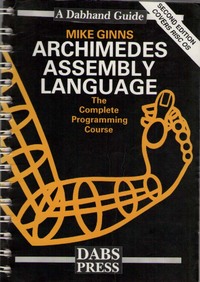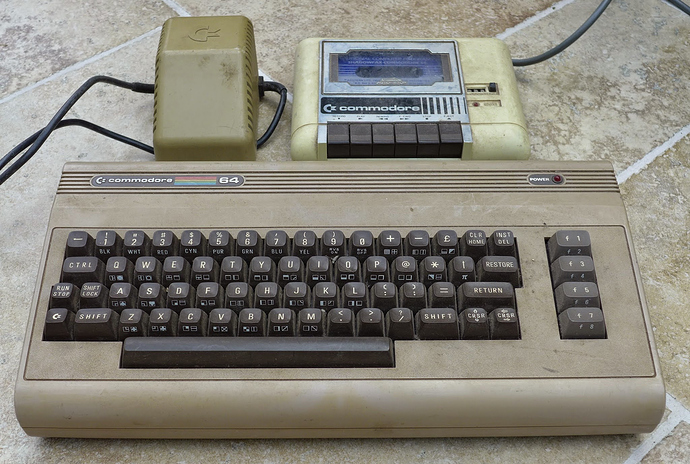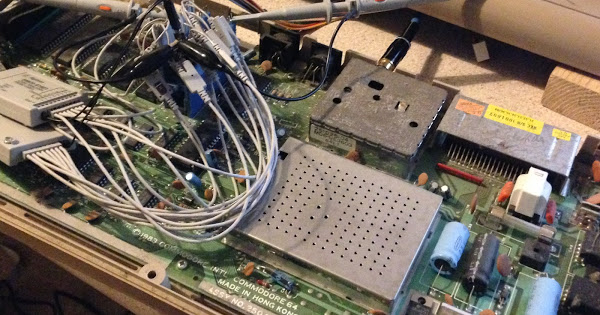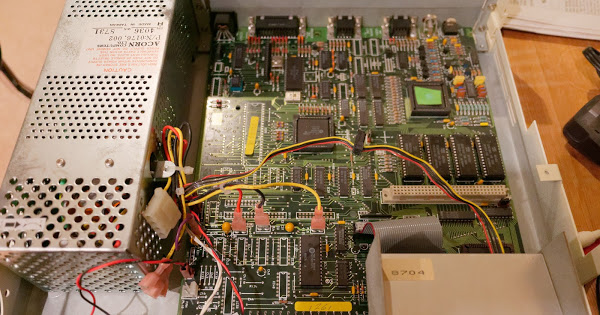I did two things yesterday - visited @hoglet with an untested C64, and visited @Revaldinho with a no-longer-working Acorn Archimedes A305. Read on!
In 2016 I bought a couple of untested and filthy computers from a junk shop, never since did anything with them, so took this C64 around to @hoglet yesterday to investigate:
We thought it might be interesting to see how its video output looks, for HDMI dongle project purposes. But as it turns out, it powered up with a blank screen, so we ended up investigating the 6510’s pins to see what signals were doing what. Eventually, with the logic analyser, and referring to The Ultimate Disassembly, we saw that the boot vector was supplying two unexpected byte values and then the code jumped into the Basic ROM instead of the Kernal ROM. And then saw that the PLA (actually a large ROM) was failing to select the right ROM, and it turns out that this component often enough fails.
There are various projects which reimplement the ROM, some using only a 9536 CPLD on a small DIP carrier, so that’s an option - either to buy or to build. The only socketed chip here is the SID, so we’d probably remove the PLA destructively. But resurrecting this machine doesn’t appeal to much at present as a retro project, so it must go back into a storage crate.
(It turns out there’s a C64 diagnostic guide with screenshots which might have helped us.)
Dave kindly soldered in the four jump wires to my HDMI dongle board, so now the Pi can reprogram the CPLD - this seems like a very handy technology.
I then decamped to visit @Revaldinho, and handed over his A305 with busted PSU. It was gifted to me years ago and only once did I have a play with it. More recently when I powered it up the PSU let out the smoke.
We hooked up R’s bench supply, and a monitor which accepts composite, and then a second monitor, and fiddled around quite a bit before getting the right combination: not only the right monitor, with the right input selected, but also with a replacement 3V battery pack. And then power-up with DELETE held down.
The floppy drive didn’t work, nor the speaker, surely because we only had a two rail supply.
But we were able to run Basic, as a task in a window or full screen, or from the CLI bypassing the GUI. So we typed in SPHERE aka WOOLBAL and got a world record 0.74 seconds. And we noted that the machine must have been upgraded as it has 1MByte of RAM. We also typed in a couple of very short assembly programs, finding that a 2^20 decrement took 0.97 seconds. Some photos of the machine and the session:
We referred to a handy book - I think the Mike Ginns book - for tips on using the ARM assembler built into BBC Basic.

R notes that the Gotek might be just the thing for this machine, as it only needs 5V. It’s a bit tedious using a machine with no storage! But the machine has a serial port, so that’s is another way to load and save data.
Next step with this machine perhaps is to borrow or procure a riser so it can take a podule: there’s work in progress on an ARM version of R’s CPLink project, a simple board which allows a Pi to serve data to a retro host.


